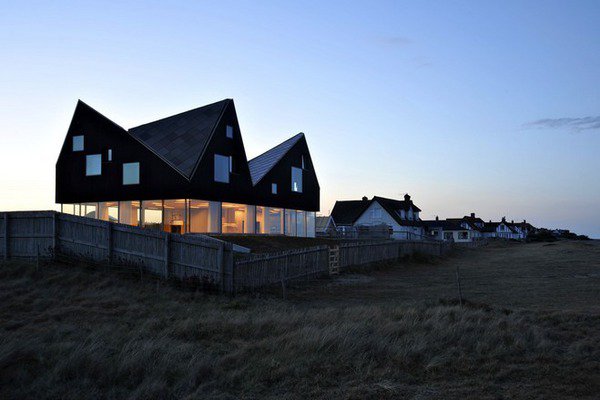Jarmund/Vigsnaes Arkitekter
dal 10/3/2014 al 8/4/2014
Segnalato da
La Galerie d'architecture Press Office
10/3/2014
Jarmund/Vigsnaes Arkitekter
La Galerie d'architecture, Paris
Constructing Views 2011-2014. A collage of images, drawings and models of sixteen completed buildings from 2011 to 2014. The views will be arranged as an architectural construction in itself, juxtaposing the different architectural characters into a spatial experience.

After a first exhibition in 2007, the Galerie d’Architecture once again has the pleasure of welcoming the Norwegian agency Jarmund/Vigsnæs Arkitekter, founded in 1995 by Einar Jarmund and Håkon Vigsnæs. Numerous articles featuring their work have been published in France and abroad, most notably thanks to The Dune House, in England, which won the 2012 RIBA Award.
The exhibition presents a collage of images, drawings and models of sixteen completed buildings from 2011 to 2014. The views will be arranged as an architectural construction in itself, juxtaposing the different architectural characters into a spatial experience.
The Aluminium Cabin
Situated in a beautiful archipelago, this seaside cabin is a replacement project for a worn-out, unpractical cabin which was dominating the site. The area’s building code and its following obstructions have formed the project in size and form, as well as an enhanced site-specific adaption to the landscape.
The cabin consists of three interconnected volumes where three outdoor spaces is created. All three outdoor rooms give several sun and shelter options during the day. The cabin is placed between two rocks and the characteristic landscape makes the cabin appear low in the terrain. The plan is programmatically divided in two by the roof ridge. One side is subdivided into bathrooms, bedrooms and kitchen — while the other side is one large living room. The division is to be seen in the opposing facades — one is private and enclosed, the other is open and transparent.
The cabin is clad in seawater resistant aluminum and has folding doors that make two of the facades completely open towards the surroundings. The aluminum façade plays along with the shifting daylight and appears altered in its expression during the day.
The Dune House
Dune House is situated in Thorpeness, England, on the Suffolk coast, replacing an existing building at the site. Thorpeness is small coastal village from the 19th century and an established holiday destination in the summer months. To get a planning permission it was important to relate to the existing, typical, British seaside strip of houses. The roofscape, the bedroom floor, somehow plays with the formal presence of these buildings, and also brings into mind a romantic remembrance of holidays at bed-and breakfasts while travelling through the UK. While the materiality of the ground floor; concrete, glass and aluminium, relates to the masses of the ground, the upper floor is a construction made of solid wood, cladding stained dark as the existing gables and sheds found in the area. The roof of the house is clad in golden sheets of steel that mirrors the changing sky. The ground floor is contrasting by its lack of relationship to the architecture of the top floor. The architectural ambiguity of the house also addresses the programmatic difference between the transparent and sociable ground floor and its private and secluded “huts” of the top floor bedrooms, which comes across as the two distinct personalities of the building.
The Log House
This family house in the mountain area of Oppdal is placed on the upper part of a sloped site, offering great views towards the south. An annex is placed on the lower part of the plot with a courtyard formed between the two. Both buildings are timber log structures placed on an elevated base wall of concrete. This foundation wall is elevated in order to handle the height differences in the surrounding terrain. Decks and roof structures are made of massive wood.
The buildings combine traditional vernacular log techniques with a modern architectonic expression. This really comes to show by using large glass surfaces mounted between the knots of the log structure. Interplay between open glass-framed parts and the more enclosed log structure arises — creating varied spaces. The static differences between large sheets of glass, and the moisture relative timber construction, has been a challenge regarding technical detailing, resulting in flexible window fixings and adjustable steel columns.
The cold part of the annex is built in another traditional technique. Remains of the timber material is used as ”bricks” set in mortar, which is possible because of the dry climate at the site. The main shape of the two houses has a clear reference to the formal language of the traditional building style, both in terms of the principal of adding volumes length vice in the sloping terrain, and the angle of the roof.
Log construction is very favorable in a cradle-to-cradle perspective: Log construction has very low energy consumption in the production phase, it is a large CO2 storage during use, and can very easily be reused, recycled or be used as a heating source after use. For this reason, log structure has exemptions in energy codes in many countries, including Norway.
A catalogue of recent work by the agency will be published to coincide with the exhibition.
Image: The Dune House, Thorpeness, Angleterre © Nils Petter Dale
Opening Tuesday, March 11 6:30 PM → 9 PM
La Galerie d'architecture
11, rue des Blancs Manteaux - Paris
Tuesday - Saturday, 11 AM - 7 PM



